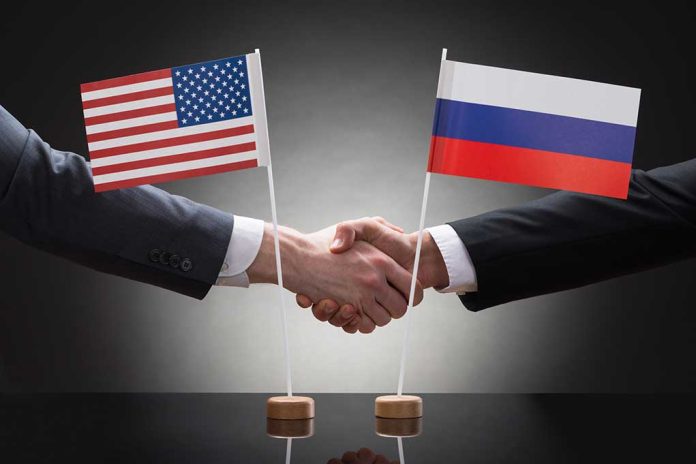
President Trump and Putin agree to a 30-day halt on Ukraine energy infrastructure attacks, paving the way for broader peace talks in the Middle East despite skepticism from Ukrainian leadership.
Key Takeaways
- Russian President Putin agreed to a 30-day pause on Ukraine energy infrastructure attacks following a call with President Trump, while rejecting a broader ceasefire proposal.
- Peace talks will commence immediately in the Middle East, focusing on energy infrastructure and a maritime ceasefire in the Black Sea.
- Ukrainian President Zelenskyy expressed openness to the proposal but warned about Moscow’s potential delay tactics and urged allies to maintain military support.
- Both Trump and Putin expressed mutual interest in improving U.S.-Russia relations and discussed the Gaza conflict with a pro-Israel stance.
- European leaders have voiced support for Ukraine and called for a complete ceasefire rather than the limited agreement currently proposed.
Limited Ceasefire Agreement Reached
Russian President Vladimir Putin has agreed to a 30-day halt on attacks targeting Ukraine’s energy infrastructure following a phone conversation with U.S. President Donald Trump. The agreement represents a potential first step toward broader peace negotiations in a conflict that has devastated Ukraine since Russia’s full-scale invasion. However, Putin rejected a more comprehensive U.S.-backed ceasefire proposal, citing concerns that Ukraine might use any extended pause to mobilize forces and rearm with Western support. The Russian leader emphasized that stopping foreign military aid and intelligence to Kyiv remains a crucial condition for resolving the conflict.
The White House announced that technical negotiations on a maritime truce in the Black Sea and discussions for a broader ceasefire would begin immediately in the Middle East. This development follows months of escalating attacks on critical infrastructure from both sides. Russian strikes have caused widespread power outages across Ukraine, while Ukrainian forces have targeted Russian oil refineries and fuel depots, impacting Russian petroleum production capacity. The agreement to pause these mutually destructive attacks could provide temporary relief to civilians before winter.
🇺🇸🇷🇺WHITE HOUSE: TRUMP AND PUTIN AIM FOR LASTING PEACE AND MIDEAST SECURITY
According to the White House, Trump and Putin agreed the Ukraine war has gone on too long and needs to end with a real, lasting peace.
They discussed an energy and infrastructure ceasefire as the first… https://t.co/Qo72dHTsVB pic.twitter.com/K3niWSU9hv
— Mario Nawfal (@MarioNawfal) March 18, 2025
Ukraine’s Cautious Response
Ukrainian President Volodymyr Zelenskyy has responded with measured openness to the U.S. proposal while expressing significant reservations. He warned that Moscow might be using ceasefire talks to buy time and regroup its forces while delaying substantive negotiations. Zelenskyy has urged Western allies to maintain pressure on Russia to pursue a comprehensive peace deal rather than limited arrangements. He specifically cautioned against any suspension of military aid to Ukraine, arguing this would only strengthen Russia’s position and undermine Ukraine’s defensive capabilities.
However there has been reported skepticism from Kyiv about the limited scope of the proposal, noting that Ukrainian officials view it as potentially giving diplomatic momentum to the Kremlin without addressing core issues of territorial integrity and sovereignty. European leaders, including outgoing German Chancellor Olaf Scholz, have expressed support for Ukraine while calling for a complete ceasefire rather than the partial measures currently agreed upon. This highlights the complex diplomatic challenge of finding terms acceptable to all parties.
Middle East Peace Talks
The agreement between Trump and Putin stipulates that extended peace talks will take place on neutral ground in the Middle East, with negotiations beginning immediately. Both leaders have reportedly acknowledged the necessity of ending the conflict with a lasting peace solution, though specific details about potential terms remain limited. The choice of a Middle Eastern venue underscores the global significance of the conflict and potentially provides a neutral setting away from NATO territory or Russian-allied nations.
In addition to addressing the Ukraine conflict, Trump and Putin discussed the ongoing situation in Gaza, with both leaders expressing a pro-Israel stance. This suggests an attempt to align on multiple international conflicts simultaneously, potentially creating a broader framework for cooperation. The discussions reflect a mutual interest in improving bilateral relations between the United States and Russia, which have deteriorated significantly since Russia’s invasion of Ukraine in 2022.
The situation remains fluid, with diplomatic channels now open but substantial challenges ahead. Initial reactions from Ukraine and European allies indicate that bridging the considerable differences between Russian and Ukrainian positions will require sustained diplomatic effort beyond these preliminary agreements on infrastructure targets. Whether this limited ceasefire can expand into more comprehensive peace talks depends on the willingness of all parties to make difficult compromises in the coming weeks.
Sources:
Putin Agrees to Pause Attacks on Ukraine Energy Infrastructure in Call With Trump
Russia’s Putin agrees to 30-day halt in attacks on Ukraine energy targets
Trump and Putin to meet in the Middle East for Ukraine peace talks







